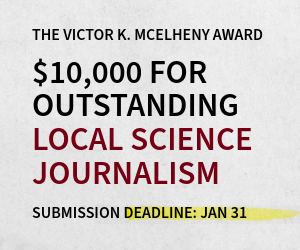This student story was published as part of the 2023 NASW Perlman Virtual Mentoring Program organized by the NASW Education Committee, providing science journalism practice and experience for undergraduate and graduate students.
Story by Mia Gawith
Mentored and edited by Sarah Webb
Some things in life can’t be put into words. Emotions are one of them.
Whether it is singing joyfully or huffing angrily, we add our vocal inflections and interpret those of others. But what about someone’s voice sends shivers down your spine or makes you smile without a second thought? Scientists have looked to other primates to see if they could help us understand how we recognize emotion.
In a new study in Scientific Reports published on July 5th, researchers from the University of Geneva, University of York, and Durham University set out to find the answer. After analyzing the similarity between different human and primate sounds, the scientists tasked people with identifying the emotion—happiness, fear, or anger—behind these sounds. Their findings suggest that evolutionary relationships alone can’t explain how we recognize emotion.
“Most of the time, other papers tend to say it’s just phylogeny,” says team head Thibaud Gruber, an assistant professor and comparative psychologist at the University of Geneva who supervised the study with Didier Grandjean. Phylogeny looks at the evolutionary history of different species to determine how related they are.
A leading hypothesis among experts has been that the more closely related we are to a species, the better we recognize their emotions. However, Gruber and his colleagues wanted to see if other factors could be involved in developing our emotional expressions.
Gruber and Grandjean were inspired by study co-author Katie E. Slocombe, whose previous work showed that we can perceive the emotions of chimpanzees—our closest relatives—but not of macaques. But whether this came from their evolutionary or acoustic similarity to us remained unclear. If our closest ancestors sound more like humans, recognizing their emotions may come more from what we know about ourselves.
To explore this issue, the team compared the vocalizations of humans, rhesus macaques, chimpanzees, and bonobos. The team used an averaging technique for human sounds to find a middle point, or centroid. They calculated the statistical difference of the vocalizations of each monkey or ape from the human centroid to quantify how human-like they are. Bonobos and chimpanzees, for example, share 98.7% of their DNA with us. But though chimpanzees sound similar to humans, “[bonobos] basically sound like a bird,” explains Gruber.
“This isn’t the first study to look at how evolutionary relationships affect emotional communication,” says Jay W. Schwartz, a psychology professor at Western Oregon University, who was not involved in the study. “But it used a really creative [acoustic] analysis to get at that question.”
Afterwards, human participants listened to various human and primate recordings, categorizing the emotion or stating whether they heard a prompted emotion.
Human participants recognized chimpanzee vocalizations most often and struggled with macaque sounds. But the bonobos turned this evolutionary paradigm on its head. Their sounds fell awkwardly between human-like and not, sometimes baffling participants. At least when it comes to our nearest primate cousins, emotional vocalizations seem to defy a simple phylogenetic explanation. It opens up the possibility that acoustics, and possibly other factors, could play into our understanding of emotional expression.
The field of emotional communication is filled with nuance, explains Schwartz, and making sense of broad areas like emotion and evolution can be like solving a massive jigsaw puzzle. Emotion is also tricky to measure in animals, especially since they can’t tell us how they feel.
The scientists used 96 vocalizations in total, which is important to consider, says Greg Bryant, chair of UCLA’s Department of Communication, who was not involved in the study. “If you have a whole different set of recordings from these four species, you might get a completely different pattern of results.” He hopes future studies will involve at least ten times as many sound samples.
“We don’t know, even with humans, what exact acoustic features people use to make their judgements. And so, there’s a gap between what we know about the acoustic structure and then what we see in people’s performances as perceivers,” Bryant says. To begin bridging this gap, the team is currently testing a more fine-tuned method for analyzing vocalizations.
This study contributes to an ongoing effort to answer questions at the tricky intersection of emotions and evolution, explains Schwartz.
We know a horror-movie shriek from an angry shout, but we’re still trying to understand exactly how we tell them apart.
Main Image Caption: Primate vocalizations such as those from Kato, a wild chimp in Budongo Forest, may provide new insights into the origins of our emotional communication. Credit: Thibaud Gruber.
Mia Gawith studies molecular, cellular, and developmental biology at Yale University. She is a contributing writer and online editor for her institution’s undergraduate publication, the Yale Scientific Magazine. She can be reached by email at mia.gawith@yale.edu.
The NASW Perlman Virtual Mentoring program is named for longtime science writer and past NASW President David Perlman. Dave, who died in 2020 at the age of 101 only three years after his retirement from the San Francisco Chronicle, was a mentor to countless members of the science writing community and always made time for kind and supportive words, especially for early career writers. Contact NASW Education Committee Co-Chairs Czerne Reid and Ashley Yeager and Perlman Program Coordinator Courtney Gorman at mentor@nasw.org. Thank you to the many NASW member volunteers who spearhead our #SciWriStudent programming year after year.
Founded in 1934 with a mission to fight for the free flow of science news, NASW is an organization of ~ 2,600 professional journalists, authors, editors, producers, public information officers, students and people who write and produce material intended to inform the public about science, health, engineering, and technology. To learn more, visit www.nasw.org




